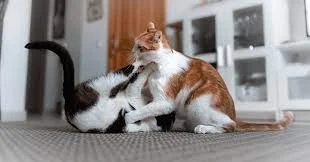Speaking of scratching, let’s address this common issue. Scratching is a natural behavior for cats, so instead of trying to stop it altogether, provide alternatives. Scratching posts, pads, and cat trees are excellent options. Place these near the furniture your cat likes to scratch. Sometimes, adding a bit of catnip to the scratching post can make it more enticing. If your cat continues to scratch the furniture, a gentle “no” followed by moving them to the post can help them understand where it's okay to scratch.
Training cats can also involve setting boundaries. Cats thrive on routine and knowing what to expect. If your cat is jumping on the counters, try using double-sided tape on the surfaces you want to keep off-limits. Cats don’t like the sticky feeling on their paws and will soon learn to avoid those areas. You can also try using aluminum foil or citrus sprays, as cats generally dislike these as well.
Let’s not forget the power of playtime. Cats often misbehave because they’re bored or have excess energy. Regular play sessions can work wonders in curbing unwanted behavior. Use interactive toys like feather wands, laser pointers, or even simple homemade toys to keep your cat engaged. Playtime not only provides physical exercise but also mental stimulation, making your cat happier and less likely to act out.
Another key aspect of disciplining a cat is providing them with a safe and enriching environment. Cats need places to climb, hide, and explore. By creating a cat-friendly home with plenty of vertical space, cozy hiding spots, and engaging toys, you can prevent many behavioral issues before they start. A happy cat is a well-behaved cat.
When dealing with litter box issues, make sure the box is clean and in a quiet, accessible location. Cats are particular about their bathroom habits, and a dirty or poorly placed litter box can lead to accidents. If your cat is having litter box problems, try adding more boxes in different locations and using unscented litter. Positive reinforcement comes into play here too—praise and treats when your cat uses the litter box correctly can reinforce good habits.
If your cat is exhibiting aggressive behavior, it’s important to stay calm. Yelling or physical punishment will only make things worse. Instead, try to identify the trigger for the aggression. Is your cat scared, in pain, or feeling threatened? Once you understand the cause, you can address it more effectively. Sometimes, simply giving your cat space and time to calm down is the best approach. For ongoing aggression, consulting a veterinarian or a cat behaviorist can provide additional guidance.
Patience is your best friend when it comes to disciplining cats. Cats don’t change their behavior overnight, and it takes time for them to learn new habits. Consistency is key—make sure everyone in your household is on the same page with the training methods you’re using. Mixed signals can confuse your cat and make training more difficult.
Remember, our goal is to make our cats feel safe and loved while teaching them how to coexist peacefully in our homes. Positive reinforcement, providing alternatives, and creating an enriching environment are all effective ways to discipline your cat without causing harm. With a little patience and understanding, you’ll find that your cat can be both well-behaved and happy.
So, next time your feline friend is causing a bit of chaos, take a deep breath and remember these tips. Your cat might not always be perfect, but with love and gentle guidance, they can learn to be the best version of themselves. Happy training!














